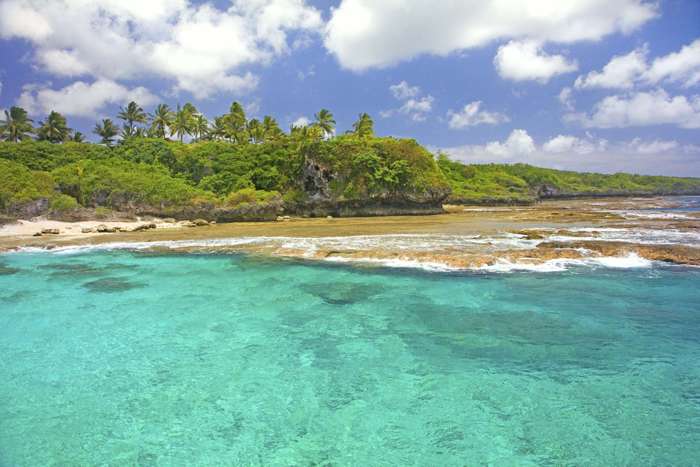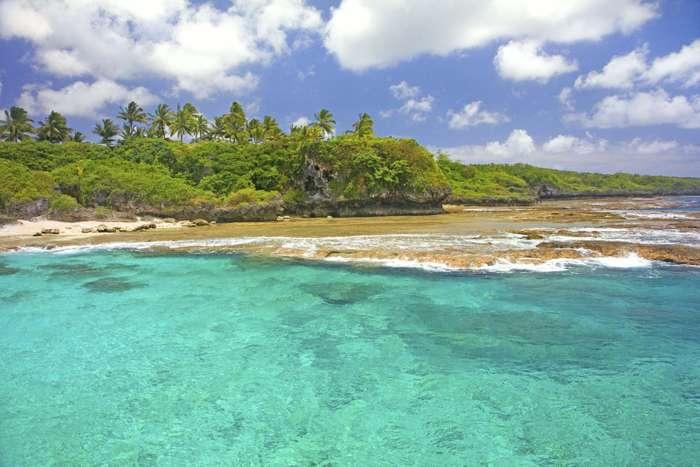China and Niue signed a Memorandum of Understanding (MOU) for cooperation on the Belt and Road Initiative (BRI) in July 2018.

Niue, internally self-governing island state in free association with New Zealand. It is the westernmost of the Cook Islands but is administratively separate from them. Niue lies some 1,340 miles (2,160 km) northeast of Auckland, New Zealand, and 240 miles (385 km) east of the Vavaʿu Group of Tonga, in the southwestern Pacific Ocean. Niue is sometimes called “the Rock of Polynesia,” or simply “the Rock.” The capital and largest settlement is Alofi. Area 100 square miles (260 square km). Pop. (2011) 1,613.
-- Land And People
Niue is a roughly oval, raised coral island that is about 40 miles (65 km) in circumference. The island has two distinct levels. The upper level, a central plateau with a maximum elevation of approximately 200 feet (60 metres), slopes steeply down at its edges to the lower level, a coastal terrace about 0.3 miles (0.5 km) wide and 80–90 feet (25–27 metres) high, which in turn slopes down to meet the sea in small cliffs. A fringing reef surrounds the island. Erosion has created craggy stone formations in the porous limestone along the coastline, resulting in caves and pools such as the Limu Pools on the northwest edge of the island.
The population is mostly Polynesian. English is widely spoken, and a large number of people speak both English and Niuean, a Polynesian language akin to Tongan and Samoan; a small proportion speak only Niuean. The inhabitants are predominantly Christian. Most people live in villages on the fertile coastal strip, which is intensively cultivated. The population declined throughout the late 20th and early 21st centuries as many Niueans migrated to New Zealand because of limited economic prospects at home. In the early 21st century there were many times more native-born Niueans and their descendants living in New Zealand than on Niue itself.
-- Economy
Niue’s currency is the New Zealand dollar. The economy is based mainly on agriculture. About one-fourth of the land is arable and is held in traditional family patterns; land ownership is passed down through family lines, and, by law, land cannot be sold to foreigners. Passion fruit, coconuts, pawpaw, and limes are cash crops. Subsistence crops include taro (locally called talo), yams, bananas, sugarcane, papaya, guava, and citrus fruits. Livestock includes pigs, chickens, and cattle, and fishing is conducted for domestic needs. The government has made the development of the fishing industry a priority, and a fish-processing plant was opened in the village of Amanau in 2004. About one-fifth of the land is forested. Manufacturing is centred on processing crops and includes lime juice, passion fruit, copra, honey, leather goods, and handicrafts for export. An industrial park was established in Fonuakula in the early 21st century. Tourism makes a growing contribution to the economy.
-- Transport
Alofi is the main port, and the island has a small airport as well. New Zealand is the major trading partner and source of financial aid. Continued financial assistance from New Zealand and international aid agencies, as well as remittances from relatives overseas, remain the key elements in maintaining a relatively high standard of living. The sale of postage stamps to philatelists and of fishing licenses as well as the provision of offshore banking services have also been important revenue sources.
(The above information from Internet)




 A single purchase
A single purchase









